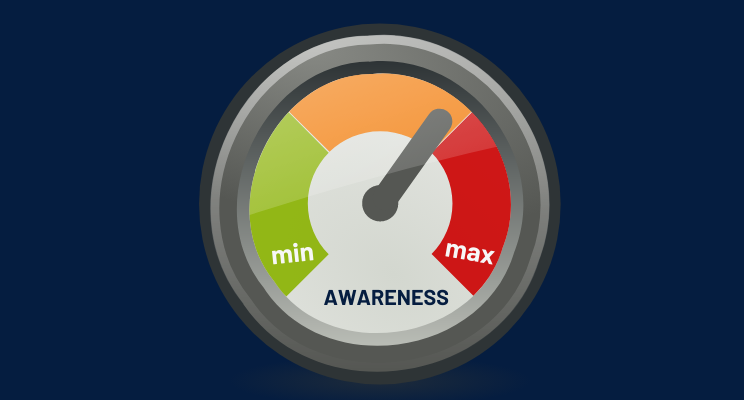Brand awareness is more than just a buzzword—it’s the cornerstone of a successful business strategy. But what exactly does it mean? Simply put, brand awareness is the extent to which consumers recognize and remember your brand. It’s that moment when someone thinks of a product or service and your brand name instantly comes to mind. And why is this important? Well, because measuring brand awareness is directly linked to consumer decisions. The more aware people are of your brand, the more likely they are to choose your products over those of your competitors.
Types of Measuring Brand Awareness

Aided Brand Awareness
Aided brand awareness occurs when consumers recognize your brand with a little help. For instance, if someone is shown a list of brand names and they can identify yours, that’s aided awareness. It’s like giving someone a hint—they remember, but they might need a little nudge.
Unaided Brand Awareness
Unaided brand awareness is a stronger indicator of brand strength. It refers to consumers being able to recall your brand without any prompts. If a consumer thinks of a category like “running shoes” and immediately says “Nike,” that’s unaided awareness. It’s like knowing the answer to a question without any clues.
Top-of-Mind Awareness
Top-of-mind awareness is the ultimate goal. This is when your brand is the first one consumers think of in a given category. It’s not just about being known; it’s about being the first one they think of. This level of awareness often translates to brand loyalty and higher sales.
Key Metrics for Measuring Brand Awareness
Measuring brand awareness isn’t just about asking people if they know your brand. It involves analyzing several key metrics that provide a clear picture of how well your brand is recognized and remembered.
Search Volume Data
Search volume data is a powerful indicator of brand awareness. It shows how often people are searching for your brand name online.
How to Track Search Volume
You can track search volume using tools like Google Trends or Ahrefs. These platforms show the frequency of searches for your brand over time, helping you understand trends and spikes in awareness.
Tools for Measuring Search Volume
Google Trends, Ahrefs, and SEMrush are some of the most popular tools for measuring search volume. They offer detailed insights into how often your brand is being searched and how this data compares to your competitors.
Social Media Mentions
Social media is where conversations about your brand are happening in real-time. Monitoring social media mentions can give you an immediate sense of your brand’s visibility and how it’s being perceived.
Monitoring Brand Mentions on Social Media
Tools like AIM Insights and Hootsuite Insights allow you to track every mention of your brand across social platforms. Whether it’s a tweet, a Facebook post, or an Instagram story, you’ll know when and where your brand is being discussed.
Sentiment Analysis
It’s not just about how often your brand is mentioned; it’s also about what people are saying. Sentiment analysis helps you understand the tone of these mentions—whether they’re positive, negative, or neutral. This insight is crucial for gauging public perception and making necessary adjustments to your strategy.
Brand Recall Surveys
Brand recall surveys are a direct way to measure how well consumers remember your brand.
Designing Effective Surveys
Creating an effective brand recall survey involves asking the right questions. You might ask consumers to name brands they think of in a specific category or to recall your brand after a series of unrelated questions.
Analyzing Survey Data
The data from these surveys can reveal not only how well your brand is remembered but also how it compares to competitors. Analyzing this data helps you identify strengths and areas for improvement in your brand strategy.
Website Traffic
Your website is often the first place consumers go to learn more about your brand. Measuring website traffic can indicate how many people are aware of your brand and are seeking more information.
Importance of Website Traffic in Brand Awareness
An increase in website traffic is often a sign of growing brand awareness. When people hear about your brand through ads, social media, or word of mouth, they’re likely to visit your website to learn more.
Tools to Monitor Website Traffic
Google Analytics is the go-to tool for tracking website traffic. It provides detailed reports on the number of visitors, their behavior on your site, and where they’re coming from, giving you a clear picture of your brand’s online presence.
Media Coverage
Media coverage is another critical metric for measuring brand awareness. Positive mentions in reputable publications can significantly boost your brand’s visibility.
Tracking Media Mentions
Using tools like AIM Insights or Meltwater, you can track every instance of your brand being mentioned in the media. This includes newspapers, magazines, blogs, and online news sites.
Analyzing Media Impact
Not all media mentions are created equal. Analyzing the impact of these mentions involves looking at the reach, sentiment, and context. A feature in a leading industry publication can do wonders for your brand awareness.
Tools for Measuring Brand Awareness
There are numerous tools available to help you measure brand awareness effectively.
Google Analytics
Google Analytics is essential for tracking website traffic and understanding how visitors interact with your site. It’s a key tool for any brand looking to monitor and increase its online presence.
AIM Insights
AIM Insights offers deep insights into brand mentions across social media and news outlets. It’s an excellent tool for tracking both the quantity and quality of brand mentions.
Mention
Mention is another powerful tool for monitoring your brand across social media and the web. It’s particularly useful for real-time tracking of brand mentions, allowing you to respond quickly to any issues or capitalize on positive buzz.
Hootsuite Insights
Hootsuite Insights integrates social media monitoring with advanced analytics, making it a comprehensive tool for managing your brand’s online presence.
Ahrefs
Ahrefs is primarily known for SEO, but it’s also valuable for tracking search volume and backlinks, both of which are indicators of brand awareness.
How to Increase Brand Awareness
Measuring brand awareness is only half the battle—you also need to know how to increase it.
Content Marketing
Creating Engaging Content
Content is king when it comes to building brand awareness. By creating high-quality, engaging content that resonates with your audience, you can increase your brand’s visibility and credibility.
Utilizing SEO Strategies
SEO isn’t just about ranking high on Google; it’s also about making sure your content is found by the right people. Effective SEO strategies can drive more traffic to your website and increase brand awareness.
Social Media Campaigns
Crafting Effective Campaigns
Social media campaigns are a direct way to reach your target audience and increase brand awareness. By crafting campaigns that speak to your audience’s needs and interests, you can create a lasting impact.
Influencer Collaborations
Collaborating with influencers who align with your brand can give you access with a broader audience and boost your brand’s credibility. Influencers have the power to introduce your brand to potential customers who trust their recommendations, making it an effective way to enhance brand awareness.
PR and Media Outreach
Building Relationships with Media
A well-executed PR strategy can significantly increase your brand’s visibility. Building relationships with journalists and influencers in your industry allows you to secure media coverage that can introduce your brand to a larger audience.
Leveraging Press Releases
Press releases are an excellent tool for announcing new products, services, or milestones. A well-crafted press release can be picked up by various media outlets, providing your brand with significant exposure.
Advertising Strategies
Online Advertising
From Google Ads to social media ads, online advertising offers a direct way to get your brand in front of your target audience. By using data-driven targeting, you can ensure that your ads are reaching the right people, driving both brand awareness and conversions.
Traditional Advertising
Don’t underestimate the power of traditional advertising methods like TV, radio, and print ads. While digital marketing dominates today, traditional ads can still be an effective way to reach older demographics or local audiences.
Challenges
Data Accuracy
One of the biggest challenges in measuring brand awareness is ensuring the accuracy of your data. Metrics like social media mentions and website traffic can give you a general idea of brand awareness, but they may not always reflect true consumer perception.
Budget Constraints
Measuring brand awareness effectively often requires investment in tools and resources, which can be a hurdle for smaller businesses. Tools like AIM Insights or Mention come at a cost, and not every company can afford to use them consistently.
Integrating Multiple Data Sources
Brand awareness is measured through various metrics—social media mentions, website traffic, media coverage, etc. Combining these data sources to get a cohesive understanding of your brand’s visibility can be challenging. However, using tools like Google Data Studio can help streamline this process.
Case Studies
Examining successful brand awareness campaigns can provide valuable insights and inspiration for your strategies.
Case Study 1: Nike’s “Just Do It” Campaign
Nike’s “Just Do It” campaign is a classic example of effective brand awareness strategy. Launched in 1988, the campaign leveraged motivational messaging and athlete endorsements to resonate with a wide audience. The slogan became synonymous with the brand, fostering a strong emotional connection with consumers and establishing Nike as a leader in the athletic apparel industry.
Case Study 2: Coca-Cola’s “Share a Coke” Campaign
Coca-Cola’s “Share a Coke” campaign personalized their products by replacing the brand name with popular first names. This personalization encouraged consumers to seek out bottles with their names and share them with friends and family, both in person and on social media. The campaign significantly increased sales and social media engagement, showcasing the power of personalization in boosting brand awareness.
Case Study 3: Dove’s “Real Beauty” Campaign
Dove’s “Real Beauty” campaign aimed to challenge traditional beauty standards by featuring women of diverse shapes, sizes, and backgrounds. This inclusive approach resonated with a broad audience, fostering a positive brand image and enhancing brand loyalty. The campaign not only increased brand awareness but also sparked conversations about beauty and self-esteem, reinforcing Dove’s commitment to authenticity and empowerment.
Future Trends
As technology and consumer behaviors evolve, so do the methods for measuring brand awareness. Embracing these advancements can provide deeper insights and more accurate measurements.
AI and Machine Learning in Brand Measurement
Artificial Intelligence (AI) and Machine Learning (ML) are revolutionizing brand awareness measurement by automating data analysis and uncovering patterns that might be missed by traditional methods. These technologies can process vast amounts of data from various sources, providing real-time insights and predictive analytics that can inform strategic decisions.
The Role of Big Data
Big Data plays a crucial role in understanding consumer behavior and brand performance. By analyzing large datasets, brands can identify trends, preferences, and emerging markets, enabling more targeted and effective awareness campaigns. The integration of Big Data with other technologies like AI enhances the ability to measure and optimize brand awareness with greater precision.
Personalization in Brand Awareness Strategies
Personalization continues to be a significant trend in marketing. Tailoring brand messages and experiences to individual preferences can significantly enhance engagement and brand recall. Advanced data analytics allows brands to create highly personalized campaigns that resonate with specific audience segments, leading to increased brand awareness and loyalty.
Conclusion
Measuring brand awareness is crucial for understanding how well your brand is recognized and remembered by consumers. By utilizing a mix of metrics, tools, and strategies, you can gain a comprehensive view of your brand’s presence in the market. Whether you’re analyzing search volume data, monitoring social media mentions, or conducting brand recall surveys, each method offers valuable insights into how your brand is perceived. As you look to increase brand awareness, consider the power of content marketing, social media campaigns, and PR strategies. However, it’s equally important to be aware of the challenges, such as data accuracy and budget constraints, that can impact your efforts.
Ready to take your brand awareness to the next level? Request a demo from AIM Technologies to see how our advanced tools and insights can help you accurately measure and enhance your brand’s presence in the market. Don’t miss the opportunity to elevate your brand’s visibility and connect with your audience more effectively.




